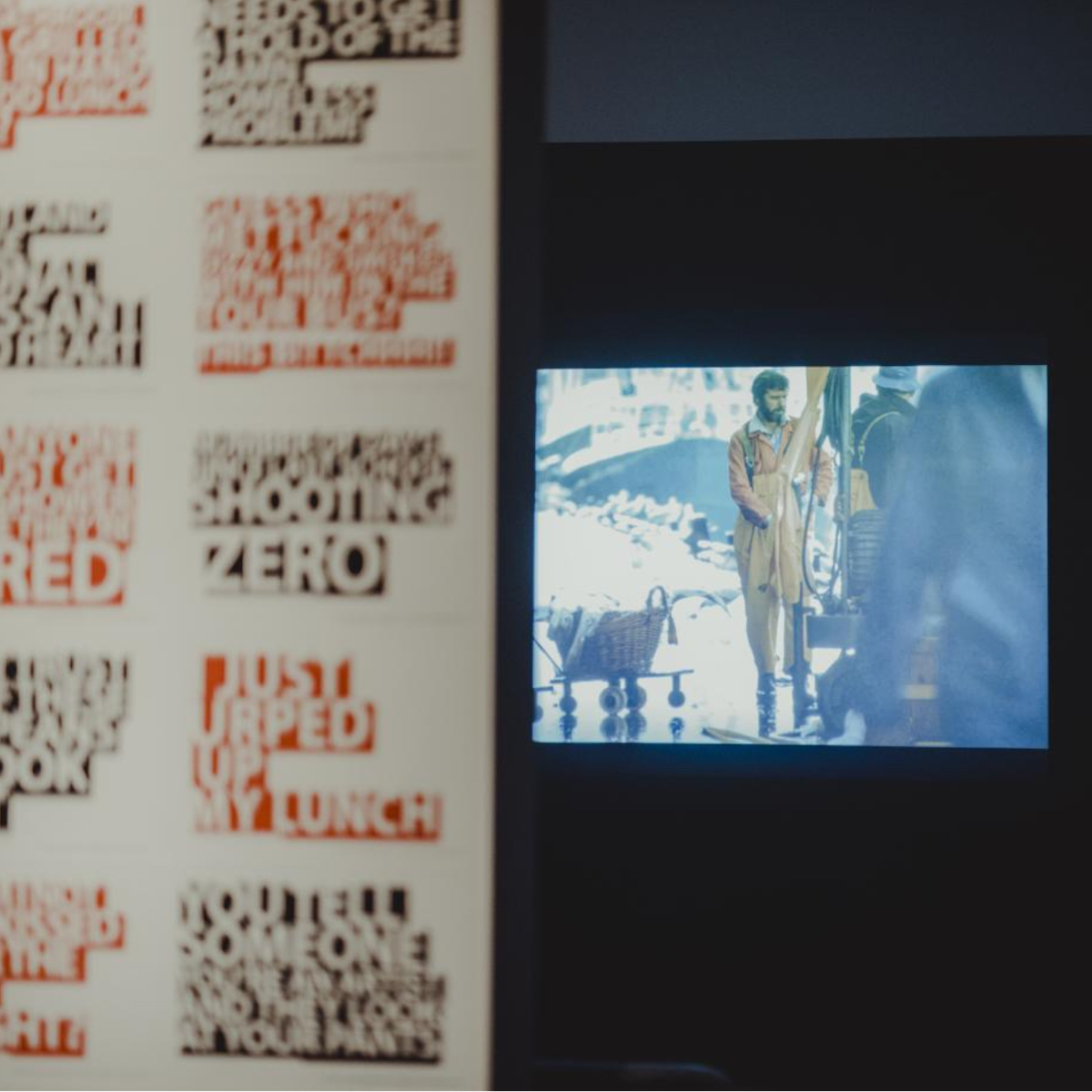
Installation view: Thomson and Craighead: Academy of Saturn, 2018. Photo by Anna Caitlin.
Thomson and Craighead: Academy of Saturn
Image Gallery Exhibition FileFebruary 2 - April 26, 2018
Since the early 1990s, celebrated UK artist-collaborators Jon Thomson & Alison Craighead have explored the visual, statistical, and poetic nature of networked information and its relation to capitalism, war, and everyday life. The title of the exhibition—The Academy of Saturn—comes from Voltaire’s 1752 novella Micromégas, in which colossal astral travelers from The Academy of Saturn visit earth and engage in a philosophical discussion with a group of scientists. Radical scale shifts of knowledge and comprehension result in an absurd, zero-sum exchange between the species; the story is an acerbic parable about the inanity of war and the value of external perspective. With kindred tenacity and wit, Thomson & Craighead explore global information’s competing—and increasingly intertwined—experiences of intimacy and incomprehensibility, touching information to be here now.
Wednesday, February 7, at 6:30 pm, Public Lecture in Eliot Chapel
Followed by a celebration with the artists at the Cooley Gallery.
On view Friday, February 2—Thursday, April 26
The exhibition is open Tuesday through Sunday, 12:00—5:00 pm. Free and open to the public.
Distillation, order, and observation take different forms throughout the exhibition. The monumental Horizon (2009–present) comprises a grid of real-time webcam images from every time zone in the world. In Thomson’s words: “The result is a constantly updating array of images that read like a series of movie storyboards, but also as an idiosyncratic global electronic sundial.” As Horizon conjoins time and space in axial form, it amplifies the lyricism of each circadian landscape, drawing us closer to feeling time as the work surveils it across distance.
Alongside their more ethereal projects, Thomson & Craighead snare and repurpose networked information in material form, often working with streams of personal utterance and inquiry. For The Academy of Saturn, the artists have created a new iteration of their text-based project London Wall (2010–present), entitled, appropriately, Portland Wall. The work is based on public “status updates” posted on Twitter and Facebook in a three-mile radius around the Cooley. The texts are transformed into graphic posters and installed onto the walls of the gallery, forming an architecture of endlessly combinable concrete poetry—fleeting thoughts, captured and echoed in their community of origin. In Untitled (Balloon work) (2016), the names of military actions are printed onto balloons roaming across the floor of the Cooley. These physical balloons are accompanied by video footage of a corporate balloon drop in which a group of women spontaneously pop hundreds of balloons to clear them away. The golden balloons sound like gunfire as they’re pricked, casting political spectacle and warmongering alongside capitalism and corporate culture.
Thomson & Craighead’s interest in the found poetry of historical narrative and networked culture speaks to artistic forms such as the Oulipo movement founded in the 1960s. Oulipo artists constructed their work using patterned constraints such as palindromes and the S+7 technique, in which each noun in a text is replaced with the seventh noun that follows it in the dictionary. The artists’ sculpture Here (2011–present, also produced in a new iteration for the Cooley) is a regulation street sign displaying the distance the sign exists from itself if pointing in the direction of the North or South pole. Confusion ensues as one tries to conceptualize the work’s beginning and end, which are collapsed into the same location while simultaneously imagining the entire planet. Like a palindrome, the work encapsulates its own unidirectional significance.
Similarly, BEACON (2006) captures live search-engine phrases from around the globe, syphoning them into an unending text-stream that shadows the present. Projected in the Cooley foyer, the original online version was initiated on January 1, 2005. The artists describe BEACON as a “silent witness … a feedback loop providing a global snapshot of ourselves to ourselves in real-time.” In his recent book, Never Alone, Except for Now, Kris Cohen discusses the work’s social dynamics: “BEACON materializes search as a scene of atomized, nonreciprocal togetherness, togetherness that is only barely not the same as being totally alone. Via the liveness of the connection, BEACON situates us with others in view of an activity that is as pervasive as it is recondite: web searches.” (Duke: 2017) 115.
In the video environment Control Room (2017), a cache of 35mm color slides found in the Aberdeen, Scotland harbor archives becomes the catalyst for an emotionally evocative experience. As no information accompanied the slides, Thomson & Craighead created a narrative about the archive’s characters, places, and events. A computer program randomly combines each image and line of dialogue, evoking the recursive presence of memory.
In Corruption (2014), the artists present a series of light boxes containing image-frames from a corrupted file designed to download a computer virus. The images were captured by viewing the file on a video player, as opposed to a computer. The psychedelic scenes are beautiful—abstract and painterly—and are printed in lenticular form to shift with the viewer’s body. Corruption brings the malfunctions and distortions of technological life into a contemplative, aesthetic space. In The End (2010–present), Thomson & Craighead recontextualize place in relation to time and narrative with the simple phrase—"The End"—affixed in Gothic-style script to a window overlooking a verdant landscape. The End presents time as a translucent sliver of past and future moments and speaks to the creation of events and the fragility of life.
And lastly, the artists’ most alchemical work in the exhibition—Apocalypse (2016)— atomizes the King James Bible’s account of the horrors of the End Times in the form of a luxury perfume (developed in collaboration with Edinburgh perfumer Euan McCall). The project was inspired by Master Bertram von Minden’s fifteenth-century altarpiece depicting forty-five scenes from the Book of Revelations (housed at the Victoria and Albert Museum, London). The artists determined Apocalypse’s olfactory notes by calculating the number of times a substance, such as “blood” or “flesh,” is mentioned in the text.
